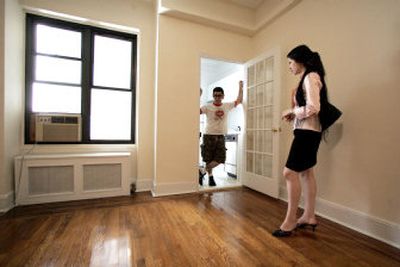Single lifestyle gaining popularity

NEW YORK – For all its crowds, Manhattan may be the country’s loneliest metropolis. It has the highest percentage of single-person households of any county in the nation, according to the U.S. Census Bureau.
“I think it’s the best way to live,” said James Conaboy, 35, a musician who, after years of living with roommates, spent a morning this week hunting for a small apartment in Manhattan’s East Village. “If you want to make a mess, you can make a mess. If you want to paint the walls a certain color, you can do it.”
Privacy, he explained, has special value in New York, where people spend their days surrounded by people.
Lured by a dizzying social scene and studio apartments, some 354,336 people were living alone in Manhattan at the time of the 2000 Census. Solos accounted for 48 percent of all households on the island, putting Manhattan ahead of other singles magnets like Washington, D.C., St. Louis, Denver and San Francisco.
Nationally, the number of Americans living alone has exceeded the number of households composed of a classic nuclear family – a married couple and their natural children – according to an analysis of the 2000 Census data published last month.
Thomas F. Coleman, executive director of Unmarried America, an association that promotes the political interests of single people, credits part of the shift to changing social norms.
People living alone, especially unmarried women, used to be viewed with sadness, he said. That old attitude has fallen away.
“Self esteem isn’t based on having children and being married anymore,” Coleman said.
Economics also probably plays a role, says Gordon F. De Jong, a professor of sociology and demography at Pennsylvania State University’s Population Research Institute.
More people are going to college, he said, meaning that they eventually get higher-paying jobs that allow them to live by themselves. Older people today have better assets, meaning they can more easily afford to live in their own homes after a spouse dies.
Among the Manhattanites living alone, a majority, 56 percent, were women. About 23 percent were people over age 65.
“I think, in some ways, the city is a wonderful place to be old and alone,” said Marcia Stein, executive director of Citymeals-on-Wheels, which delivers food to 17,000 homebound elderly in New York every day.
On a nice day, elderly folk can easily leave their homes and sit in the park, walk to the bank on the corner, go to a museum or to the neighborhood coffee shop, she said.
“They have neighbors on the same floor of their apartment building, or across the street who they probably see every day,” she said. “When an older person lives in a rural area, or a suburban area, they have to be able to drive a car. Our people don’t need to do that.”
The analysis found that the number of single-person households in the U.S. grew 21 percent in the 1990s, eclipsing the growth rates for all other types of living arrangements.
About 27.2 million Americans lived alone in 2000, accounting for about 26 percent of all households and about 9.7 percent of the overall U.S. population.
By comparison, 22 percent of households consisted of a married couple and their natural children. About 21 percent were married couples living alone. Eight percent were single parents living with at least one child.
Other combinations – including multigenerational households, unmarried partners, people living with their extended families, grandparents raising grandchildren, and other recorded types of arrangement – were less common.
The increase in the percentage of single-person households is a continuation of a trend that began decades ago. In 1950, just 9.3 percent of U.S. households consisted of people living alone, according to the Census Bureau.
Some parts of the country have continued to buck the trend of people living alone.
In Hidalgo County, Texas, an agricultural section of the Rio Grande Valley along the Mexican border where more than a third of residents live in poverty, only 13 percent of the households were singles.
Only 11 percent of all households were singles in predominantly Mormon Utah County, Utah, which covers nearly 2,000 square miles south of Salt Lake City and includes Provo, the home of Brigham Young University.